LOX
Tunnels and Loading Vents
|
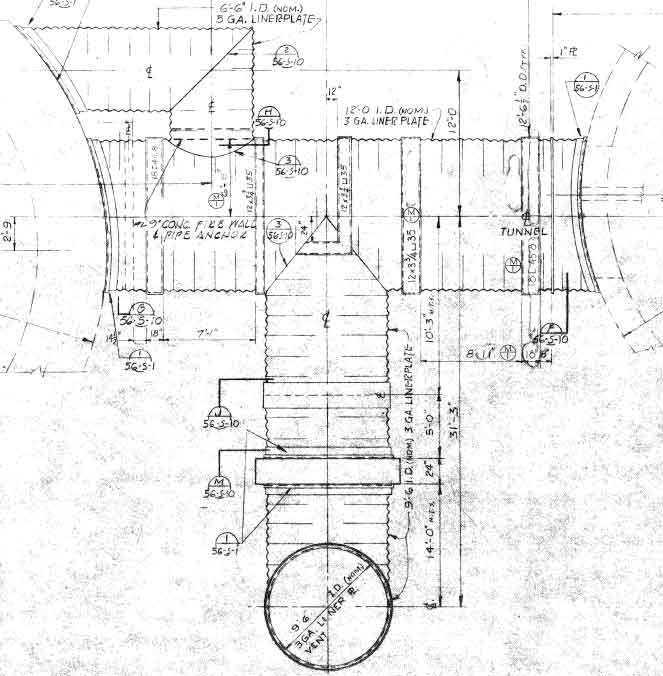
Lox
tunnel and loading vent viewed top-down. Missile silo at upper
left and propellant terminal at upper right and loading vent at lower
middle.
|
|

LOX
tunnel and loading vent, side aspect showing "fuel tunnel" at
right
|
The
LOX tunnel is a 3 gauge corrugated steel structure, 12 feet in
diameter and roughly 25 feet in length measured from the lower level
of the propellant terminal to the concrete firewall that separates it
from the missile silo. Through this conduit the various gasses
required for the oxidation of fuel and operation of the missile
systems along with compressed air were conveyed via two openings in
the silo wall.
The
LOX vent is a 3 gauge corrugated steel structure 9' 6" in
diameter rising 53' 9" from the LOX tunnel to the surface through
which the silo and propellant terminal vented evaporated LOX, gaseous nitrogen and helium and through which the supply of LOX,
nitrogen and helium were replenished from the surface.
A
smaller tunnel, 6' 6" in diameter branching from the main LOX
tunnel and given the misnomer
"fuel tunnel" carried helium, liquid and gaseous nitrogen
and compressed "utility air" which was used for pressurizing
and blanketing fuel and oxidizer tanks as well as for actuating valves
and other pneumatic components of the missile systems.
|
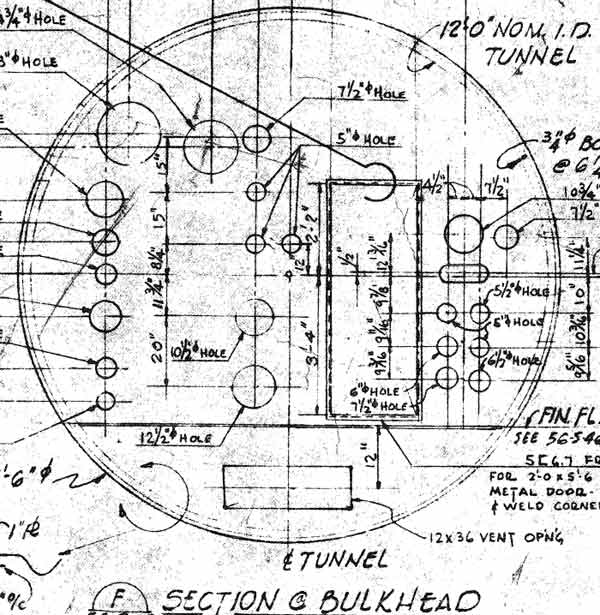
LOX
tunnel bulkhead and openings at the entrance from the propellant terminal
(see next image)
|
|

The
entrance to the LOX tunnel viewed from the lower level of the propellant
terminal
|
Reaching
LOX Tunnel #1
Access
to the propellant terminal was complicated by the removal of the upper
level platforms that interfaced with the personnel tunnel. Upon
arrival to this area I was greeted by a good 12-foot drop ending in
rusty water of indeterminate depth (see the propellant
terminals section). This
presented an effective deterrent for a year or so until I found myself
faced with the prospect of not being able to continue visiting the
site as it was up for sale. My curious nature of course got the
better of me as I plotted out areas of interest to which I had not yet
gained access or taken any photos. One of those was of course
the LOX tunnel. From the personnel tunnel, you can see
the LOX tunnel but that's about it--you cannot make out what lies
beyond. That would never do. I had to see for myself what
was back there.
Blueprints
showed a multi-branched tunnel with lots of piping and ductwork, but
the flat blue drawings were hardly satisfying and only served to whet
my curiosity all the more. After some thought, I devised a plan
to safely access the LOX tunnel. Like many plans, its execution
proved more difficult than anticipated. Old scratch--always
lurking in the minutiae.
|
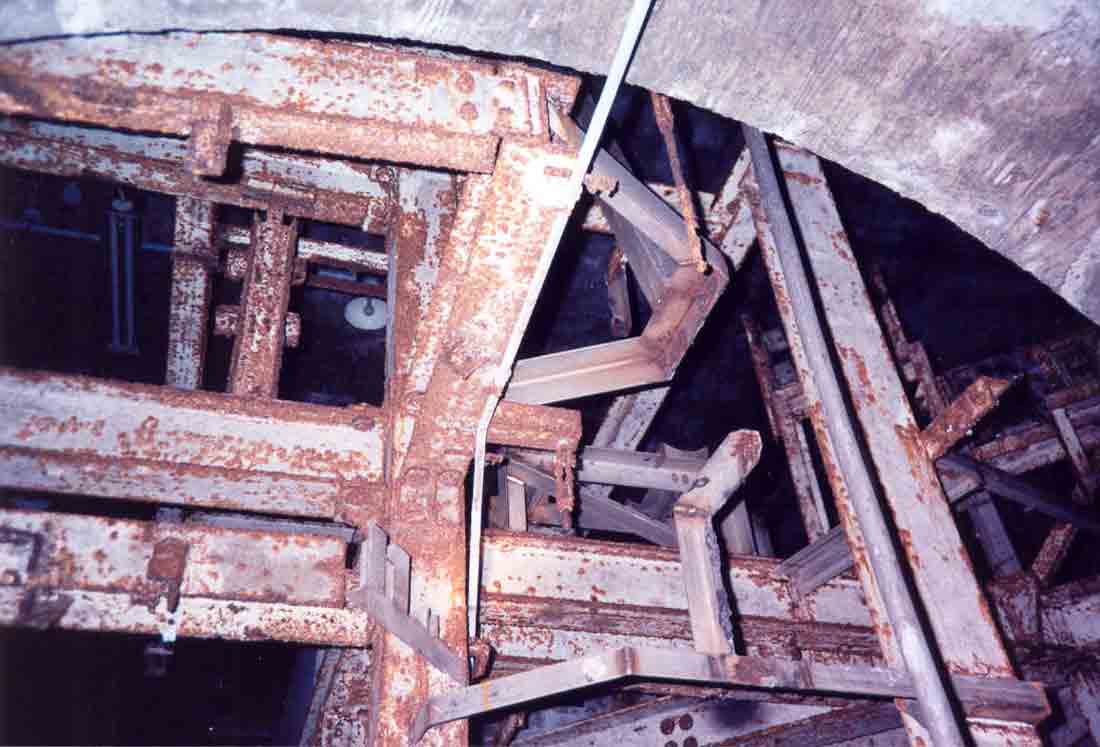
Looking
toward Propellant Terminal #1 from inside the LOX tunnel. Rust has
devastated this area since the propellant terminal is filled with
standing water that leaks in from many sources and flows into the
missile silo through the LOX tunnel.
|
There
was a ladder in one of the antenna silos which would handily surmount
the obstacle that the propellant terminal posed, but it was at least ten
feet long, heavy and obviously bulky and awkward to carry. It was
also a couple thousand yards distant from propellant terminal #1--my
intended goal. Still, it seemed the fastest and easiest way to
gain access. My plan was hatched: I would schlep the ladder out of
antenna silo #2, up the lengthily antenna tunnel and into the launcher
tunnels, through blast lock #2 and negotiating the corners there and
making my final approach to the propellant terminal where I could easily
drop the ladder down to the water. Once in place I hoped my rubber
boots would be sufficient to cross the water after descent, allowing me
access to the mysterious LOX tunnel.
|

Looking
toward Propellant Terminal #1 from inside the LOX tunnel. Note the
spring shock mounts that once carried piping through the tunnel.
Since a large portion of fixtures and conduit were stainless steel,
little remains of the plumbing of the propellant loading system
(P.L.S.).
|
Armed
with my rubber boots, trusty flashlight and respirator (mesothelioma
is no laughing matter) I set about executing my plan. First stop:
antenna silo #2 to nab the ladder. Well, it turned out that the
ladder was more like 15 feet in length and not ten feet,
and it was also secured to a high platform in the antenna silo with
twisted wire. There was a good reason for this of course, as
falling from a height of over 12 feet onto concrete and steel in the
cold dark just cannot end well. Unfortunately, to secure the
ladder for my purposes, I had first to unsecure it from the
platform which meant climbing back down after removing the securing wire
without the benefit of the safety it had offered.
I
survived this first test easily
enough and then found myself presented with an interesting physical
puzzle to solve: how to maneuver a 15 foot ridged metal ladder out of
such a constricted space.
The
antenna silos are 37' in diameter, more than enough room for the ladder
except that the center of the silo is occluded by the antenna platform
and its associated machinery. This meant I could not lay the
ladder down flat to get a straight approach to the doorway.
Also, the door opens inward meaning that it also partially blocked the
way giving me even less room to wrangle the ladder through.
Imagine trying move such a ladder through your home, say from the
bedroom and out through the living room to outside with all your
furniture in place and you might begin to envision the difficulty.
In
short I spent a good 15 minutes or more just trying to get out the door
with the ladder. Once I succeeded I was immediately met by
another obstacle as the antenna terminal meets the connecting tunnel at
a 90 degree angle. This turn is populated by pipes and ducts and
other blockage that made the task a living hell. In the end, I
actually had to run the ladder into the other antenna silo for clearance
of the corner and then lift, pull, push forward and back again multiple
times to free the ladder from the antenna terminal's tenacity.
This took about another 15 minutes to accomplish.
I
was tired, cursing, and out of breath, and I hadn't even moved the
ladder 30 feet.
|

Looking
toward Propellant Terminal #1-- a light fixture rests on pipe supports
amidst the terrific corrosion
|
Now
I am not in bad shape at all, I don't weigh much and stay very active,
but wearing a respirator invariably hinders breathing and the element
of danger stressed me out so I was wearing down much more quickly than
usual. I took a short rest before moving on.
Balancing
the ladder on my shoulder to keep the ends from dragging on the ground
I made my way to the main tunnel junction fairly easily though my
shoulder was sore. Now the antenna tunnel has a nice flat
non-skid concrete floor and was a cinch to navigate, even with an
awkward burden in tow. The launcher tunnels in contrast are
filled with loose metal debris, mud, water of varying depths and
innumerable jagged metal protrusions and precarious footing.
This was the path that awaited me as I held a flashlight in one hand
while the other kept the ladder balanced on my shoulder. Walking
down the middle of the launcher tunnels is not really desirable as it
is there that the mud and water and debris are in greatest
concentration. It is far easier in general to walk along the top
of the pipe supports on one side of the tunnel--easier that is if you
have a hand free to steady yourself that is. Walking on the
supports requires good balance and you have to step over steel
brackets every 10 feet or so which in the best of circumstances really
begs for you to steady yourself with one hand and pull yourself up
over these brackets as you go.
Now
consider my situation: no hands free; ladder balanced on and digging
into one shoulder; balancing on a narrow steel rail with mud, debris
and water below if I should slip. Every so often I have to move
the ladder to my other shoulder because it has become too
painful. This maneuver is also tricky given the terrain.
|

Looking
toward Propellant Terminal #1-- this picture was taken at another Titan
I site which has far less water in it, at least in this
area.
Photo
courtesy of Fred Epler
|
Finally
I reach blast lock #2 where the water becomes very deep in places so I
must be very careful not to take a bath by accident. At least
the turn toward launcher #1 is easy to negotiate and the tunnel beyond
is dry though still littered with junk. At the launcher I have
one more 90 degree turn and then arrive at the propellant
terminal--finally. Total time to accomplish this feat was in
excess of 90 minutes!
I
lowered the ladder down into the water and found it to be about 2 feet
deep at the time--higher than my boots. Hmmm. I desperately
wanted to avoid getting bootfuls of cold water, it would
be a long squishy walk back to the main tunnel. Worse still
would be a full dunking. Not fun.
After
securing the ladder with some cable, I climbed down to inspect the
route before me. The water was freshly clouded by the addition
of the ladder so I could not see anything below the surface.
About 20 feet of wading separated me from my goal.
With
no options, I probed the water with one foot and found some conduit
following the curved wall. I hoped it would continue over to the
LOX tunnel as I left the relative stability of my ladder and clung to
electrical conduit above as I shuffled sideways along the
wall.
|
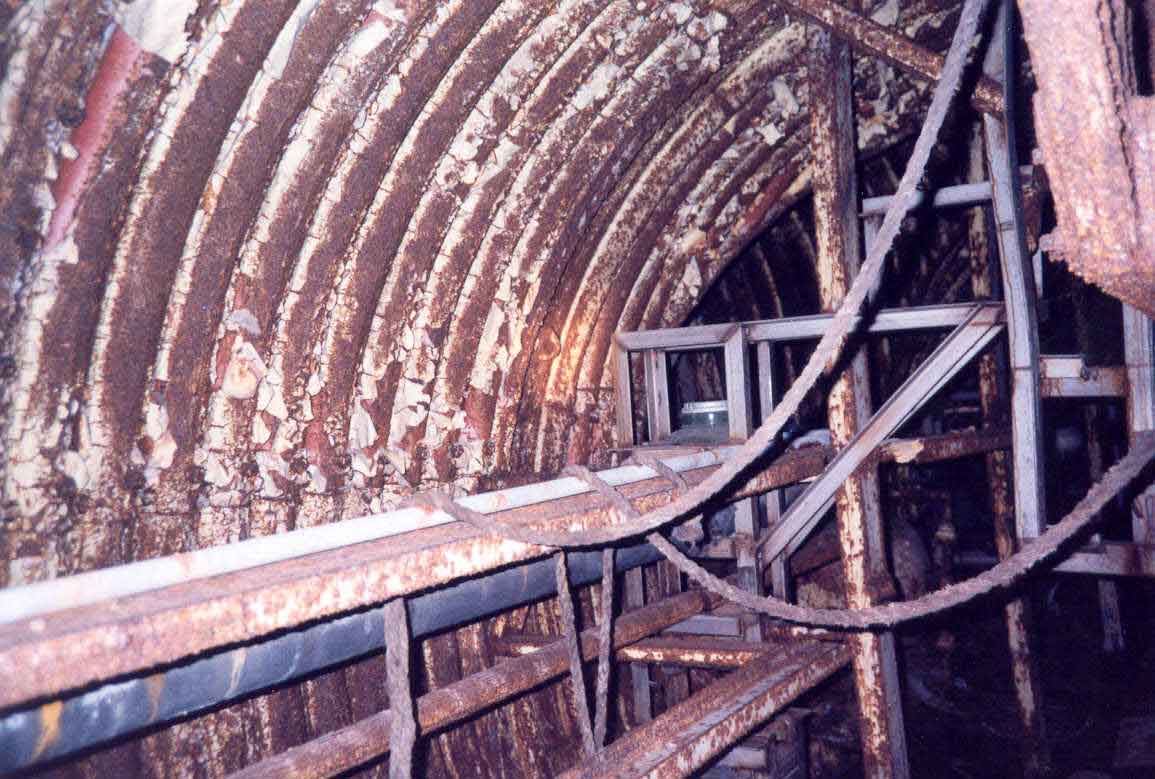
Looking
down the LOX tunnel toward the missile silo. The rope you see was
undoubtedly used by scrappers when they salvaged materials in this area.
|
About
two-thirds of the way along, the conduit disappeared leaving me with no
foothold. Again I plumbed the depths with a foot and found some
submerged junk to stand on and finally made my way to the LOX tunnel
opening which only had an inch or two of water in it. Success!
|
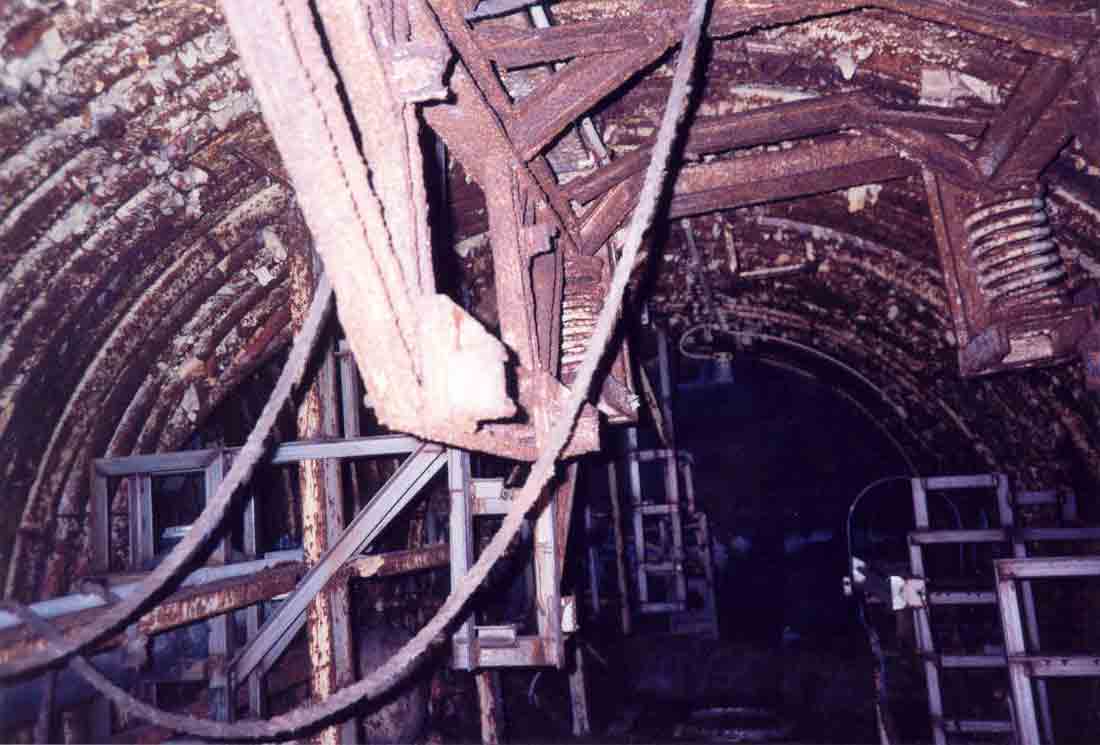
Another
view down the LOX tunnel toward the missile silo
|
I
looked around the new terrain I'd entered and surveyed the devastation
time had waged there. Every bit of steel and iron in sight was
absolutely ravaged by rust, the paint that remained either gone or
peeled and scabrous, waiting to fall off. Only stainless and
galvanized metal were relatively unscathed by corrosion and decay.
A lot of the stainless steel piping of the propellant loading system was
gone, but some remained, apparently abandoned by tight scheduling of the
scrapping contract deadlines.
|
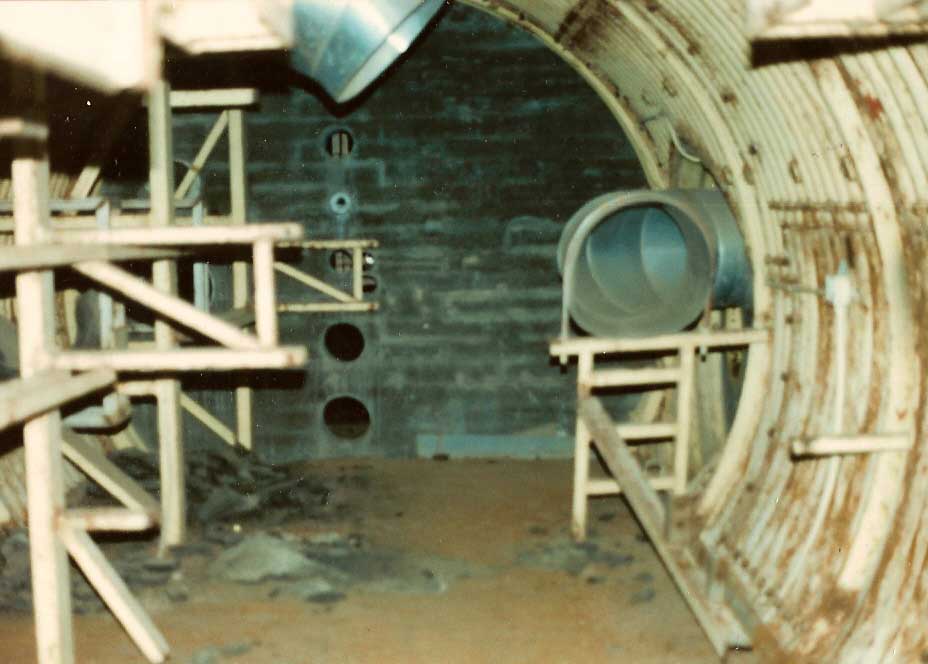
Looking
down the LOX tunnel at the concrete firewall between the tunnel and the missile
silo. Once again, this photo is from a different site and
is included to show details not easily discerned in the rusty photos of
724-C.
Photo
courtesy of Fred Epler
|
Sections
of the steel bulkhead had been cut away with a torch to remove stainless
piping and empty pipe hangers and supports festooned the ceiling and
walls. The floor was damp and covered with pipe insulation, some
fiberglass and some of it consisting of an odd pumice-stone sort of
material. I presumed the latter form was used for extremely cold
applications like liquid nitrogen and oxygen.
|

Similar
view as the previous photo, but much, much more corroded. The dark
gray concrete of the firewall is very, very dense to protect the
propellant terminal from the ever-present danger of fire or
explosion. A large piece of pipe insulation lays at bottom
center. This entire area was covered with a pumice stone like
insulation that had been stripped from the pipes. It crunched
underfoot and floated in water.
|
There
was also a lot of mold growing in the LOX tunnel. It seemed to
favor cellulose as a culture medium and had established itself on the
paper covering of the pipe insulation and on the scum collected on the
floor of the tunnel where it grew in white splotches and wispy
clumps. Not the best environment for asthmatics or probably for
unprotected breathing by anyone perhaps.
|

A
pressure accumulator tank and the stainless steel bulkhead of the LOX
vent shaft. The tank was for operating the blast valve located
behind the bulkhead.
|
Along
the floor, the water trickled enviably toward the missile silo making
its way through the concrete blast wall via a piping penetration and
dripping into the giant well that was once the launcher tube to join the
millions of cubic liters collected there.
|

The
LOX vent bulkhead from another Titan I site. This site has more
ductwork still in place.
Photo
courtesy of Fred Epler
|
|
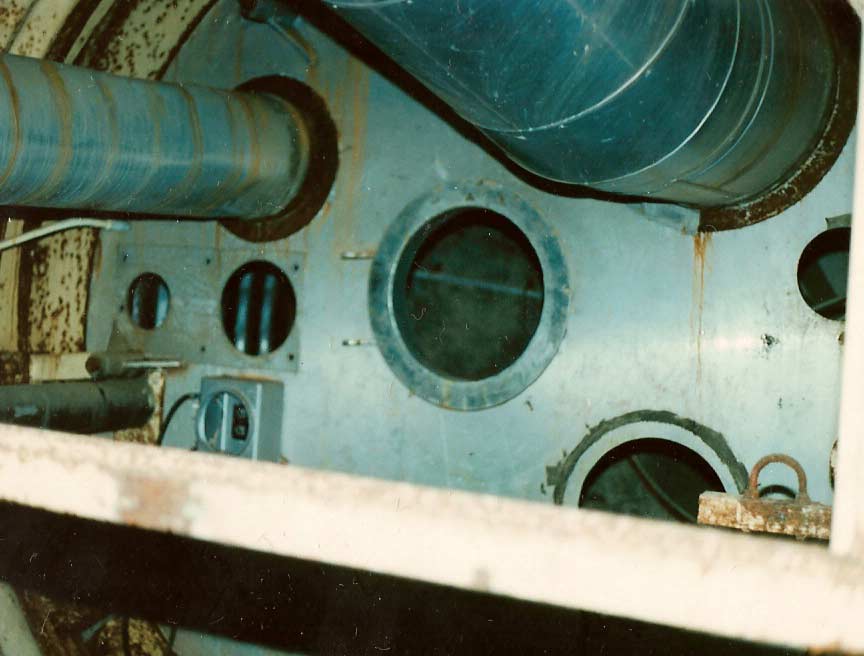
The
LOX vent bulkhead from another Titan I site--closer view.
Photo
courtesy of Fred Epler
|
The
LOX loading and vent shaft lies behind a very large stainless steel
bulkhead through which many pipes and ducts pass. Behind this
barrier is another concrete blast wall to prevent shock waves from
traveling down the shaft and damaging the missile complex. A
single blast valve allows venting of air and gasses from between these
two surfaces, waiting to slam shut in a fraction of a second if a blast
were detected.
|
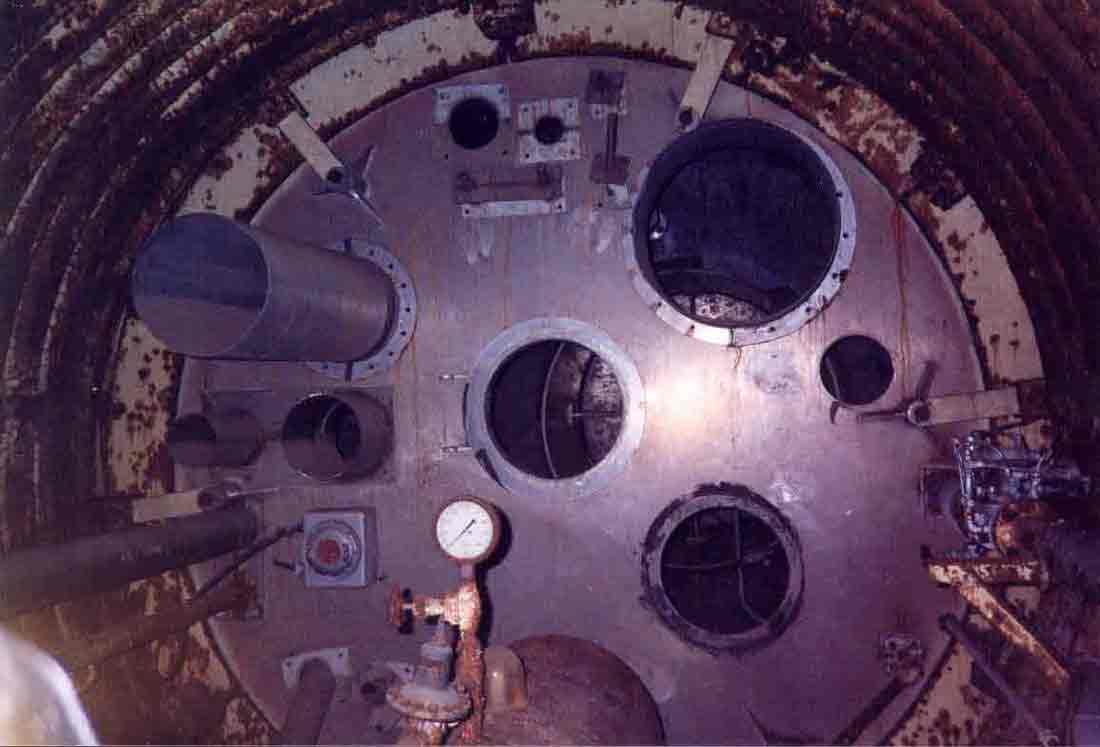
The
bulkhead between LOX Tunnel #1 and the LOX loading vent at 724-C
propellant terminal #1. Beyond this bulkhead lies another concrete
firewall and a blast valve to allow venting to the surface.
|
|

The
concrete firewall and 4' 3.75" blast valve in the LOX vent as well
as some stainless steel fill lines.
|
|
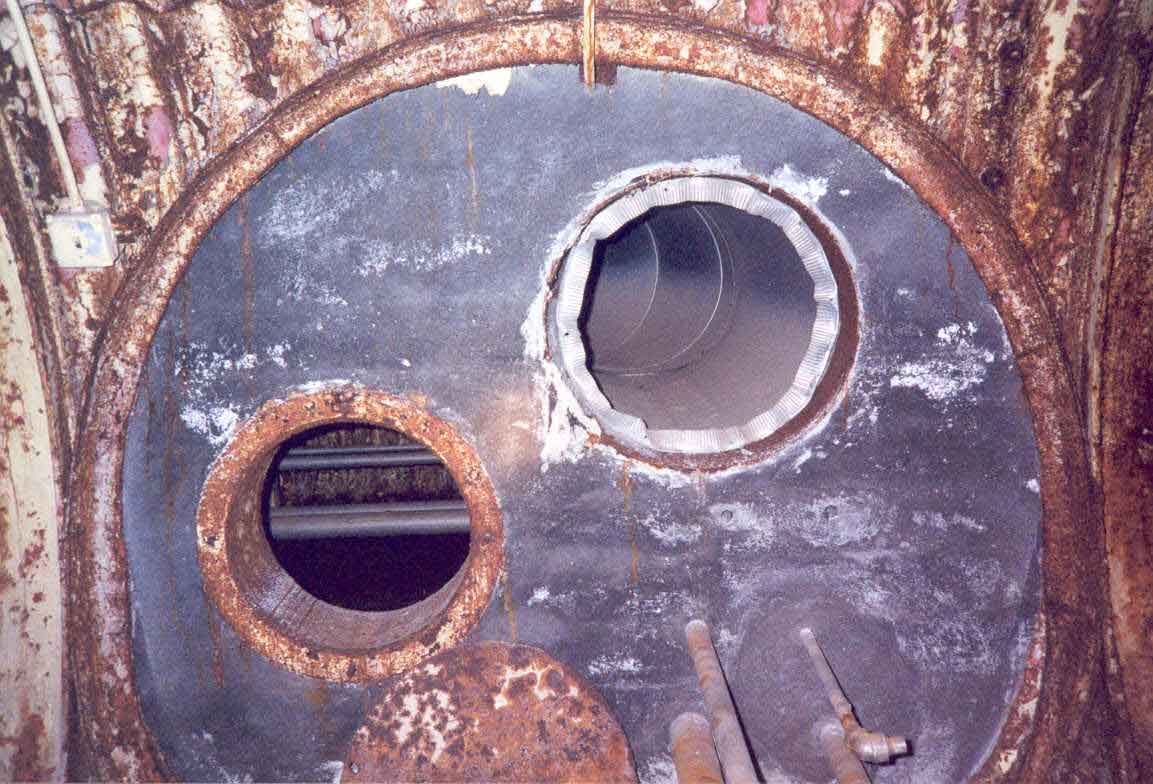
The
concrete firewall separating the "fuel tunnel" from the LOX
tunnel.
|
Close
to the silo blast wall, a smaller 6' 6" concrete wall seals off the
"fuel tunnel" through which run a large return duct from
around the 100 foot level of the missile silo and some helium, nitrogen
and compressed air lines. At left you can see the rather
constricted 20 inch man access which has been uncovered. Obviously
quick and easy entrance to the tunnel was not a high priority.
I
had to get a closer look so I set about squeezing through the
opening. For those with a full figure, this is not recommended. I had to start with one arm and shoulder first and
then the other before I could fit. Hanging onto piping on the
inside, I both pulled myself through and held my upper body out of the
12 inches of water inside the fuel tunnel. I pondered the
seriousness of getting trapped in such a place as my hips just barely
fit through the opening. Not a pretty thought as I likely
wouldn't be found for a week or so.
|

Looking
into the LOX tunnel from inside the fuel tunnel through a 20" man
access hatch. My trusty 6 volt flashlight rests in the opening.
|
|

Another
view inside the cramped fuel tunnel. Water had leaked in around
the water stop seals that connected the tunnel sections and there was
about a foot of rusty water in here when I visited this area.
|
|

The
fuel tunnel piping and ductwork entering the missile silo. The
large duct enters the silo and heads toward the personnel tunnel and
then straight down beneath the murky depths of the water that has
collected for decades.
|
Once
inside my own private burial chamber I saw it was a very short and
cramped space with little head room. I got a few photos and hoped
like hell I could get back out again.
|
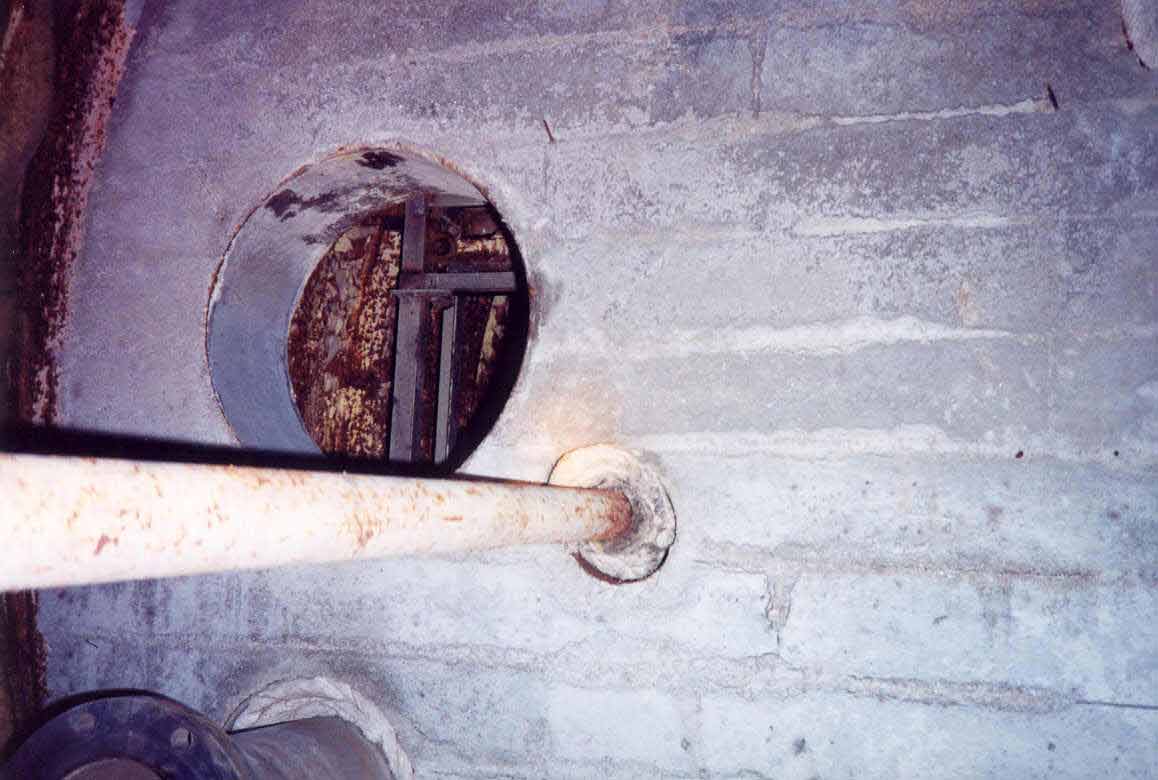
The
concrete firewall in the LOX tunnel viewed from inside the LOX
tunnel. The missile silo is one the opposite side of this wall.
|
Back
in the less claustrophobic LOX tunnel I looked at the very dense silo
blast wall. The largest LOX line had been removed but a smaller
line was still in place probably only because the pipe flange prevented
it from simply being removed. As I looked more closely I noticed
that water had pooled at the base of the wall. The floor was wet
so I thought nothing of the narrow strip of water along the wall as I scrutinized
the LOX lines, stepping closer to the blast wall as I did
so. As I stepped in the water at the base of the wall my foot
disappeared into a gap perhaps 2 feet deep and I pitched over sideways
into the wall striking my head soundly against it as I lost my
balance. This was when I became very thankful for the cheerful
yellow hard hat I'd been wearing on my journey. Instead of being
knocked silly I simply startled the hell out of myself.
What
had appeared to be just another patch of wet floor, was in fact a gap
between the tunnel and the silo wall disguised by pooled water.
Truly one has to be careful when exploring such a place, and this was a
friendly reminder of that fact.
Carefully
I peered through the blast wall opening into the missile silo and saw
the unique branched portion of the LOX line and the soggy launcher
beyond. The hole was larger than the access to the fuel tunnel
so I knew I had to go through and see the other side. You can
see here that the LOX opening on the silo side has chamfered corners
and is asymmetrical.
|
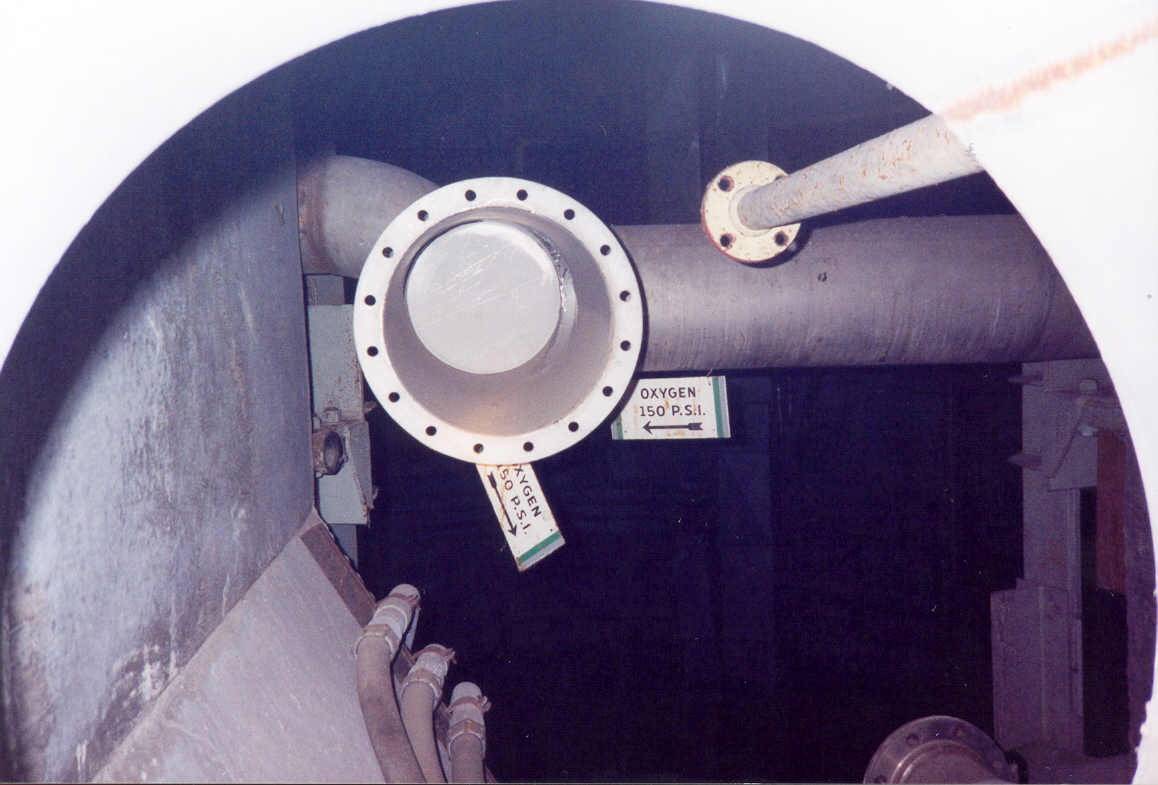
Looking
into the missile silo through the penetration through the firewall once
occupied by the 18" LOX line. The remaining run of the LOX
line can be seen continuing on into the silo where it branches to serve
both stages of the missile.
|
|
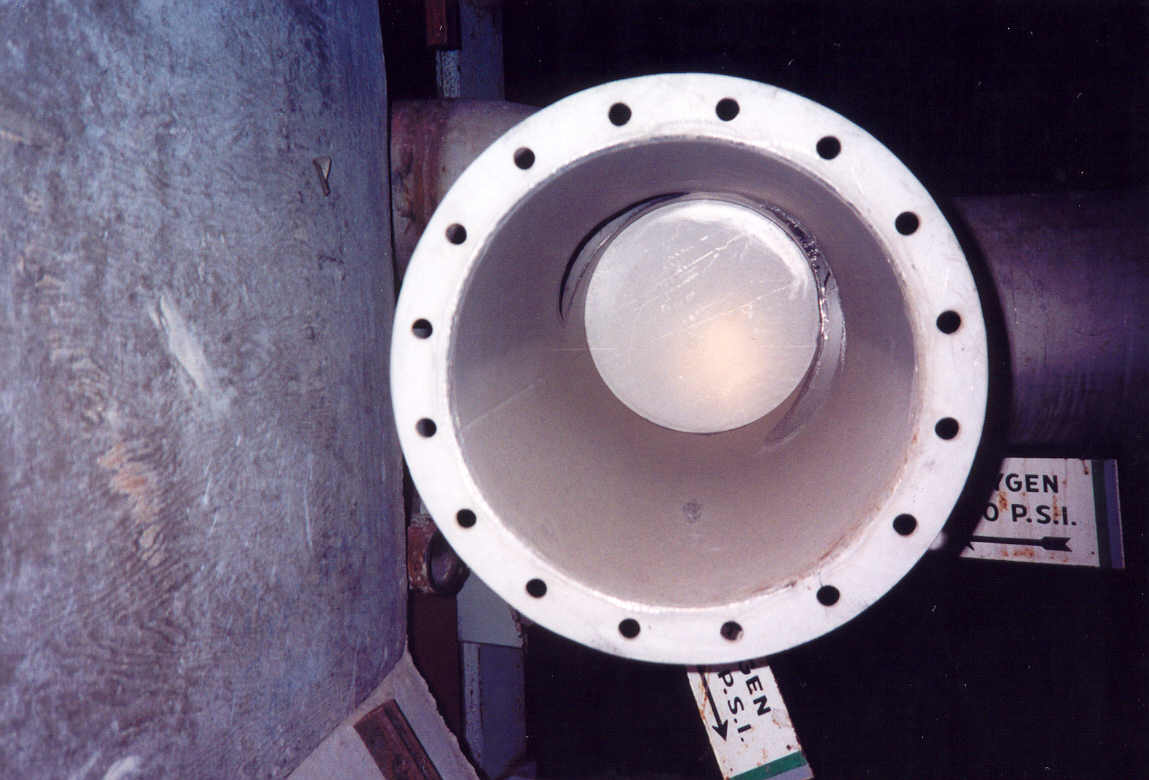
A
closer look at the LOX supply line on the silo side of the
firewall.
|
These
next few pictures are actually of the LOX tunnel opening at launcher
#2. I climbed along the conduit and ductwork once again to reach
the LOX opening--much easier than scaling to the catwalk level I have to
say.
|

A
flexible LOX connection on the silo side of the firewall. This
feature was removed from the other 2 silos.
|
|

Delusions
of grandeur: the flexible LOX connection in the missile silo.
|
|

On
the missile silo side of the LOX tunnel. This was launcher #3 which was
flooded to a greater degree than #1 or #2. The LOX tunnel here is
flooded to over 3 feet deep.
|
|
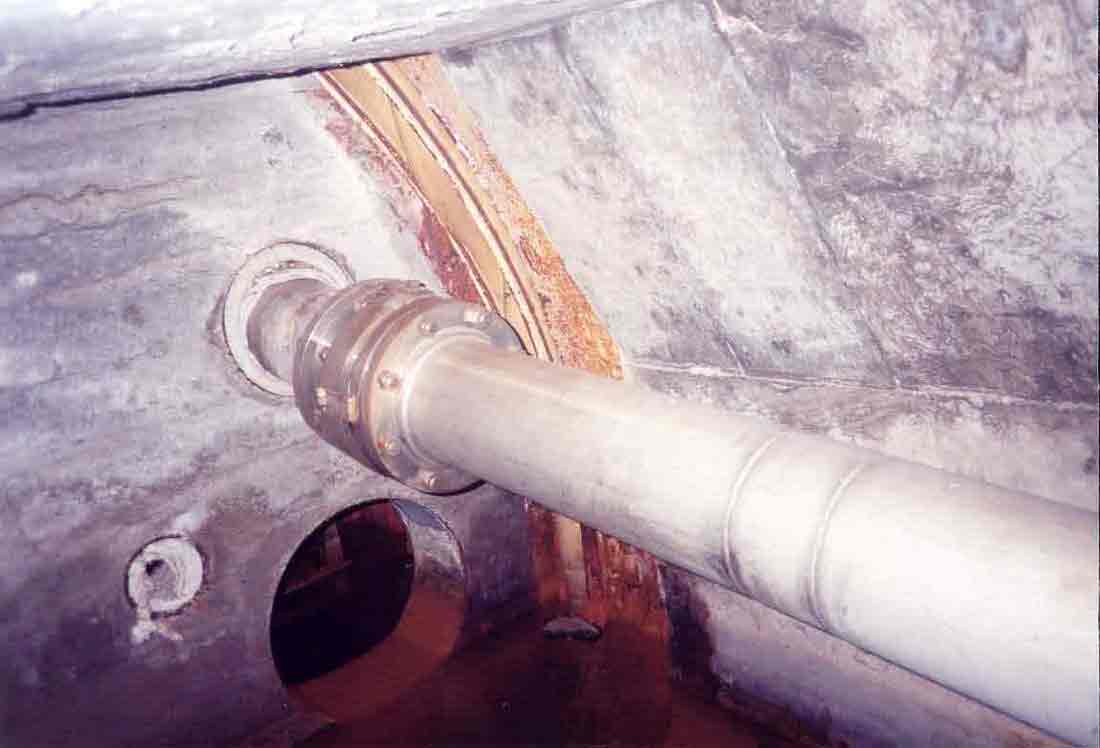
Another
LOX line showing another flexible connection.
|
|
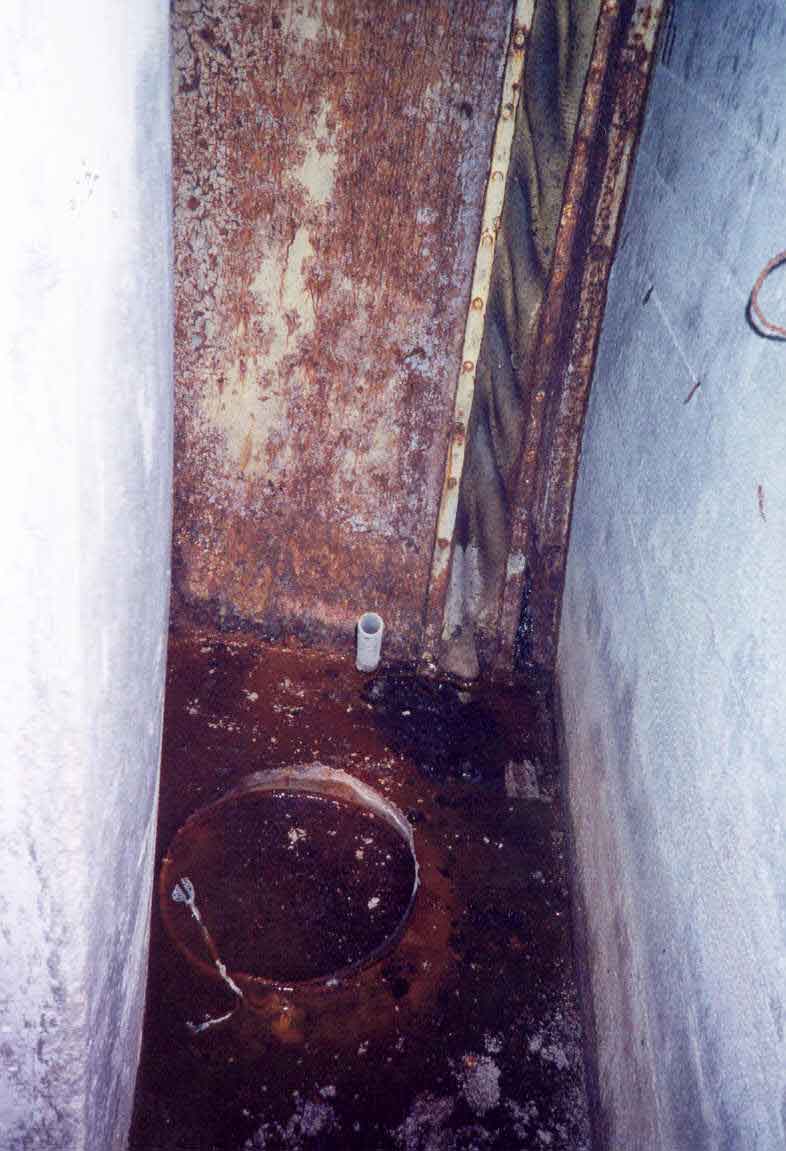
A
sump-well between the firewall and the missile silo walls. Note
the black and white speckling of vibrant colonies of mold all
around. This is back at silo #1 again.
|
|

Another
flexible LOX connection on the silo side of the firewall. These
smaller lines are likely topping lines that fill the last portion of the
missile tanks at a slower and more controlled rate until they are
full. Other lines are drains and returns for excess LOX.
Another shot at silo #1.
|
|

High
pressure nitrogen, oxygen and helium lines, penetrating the concrete
blast wall between the LOX tunnel and the launcher silo. This view
is on the silo side of the blast wall at launcher #3.
|
|
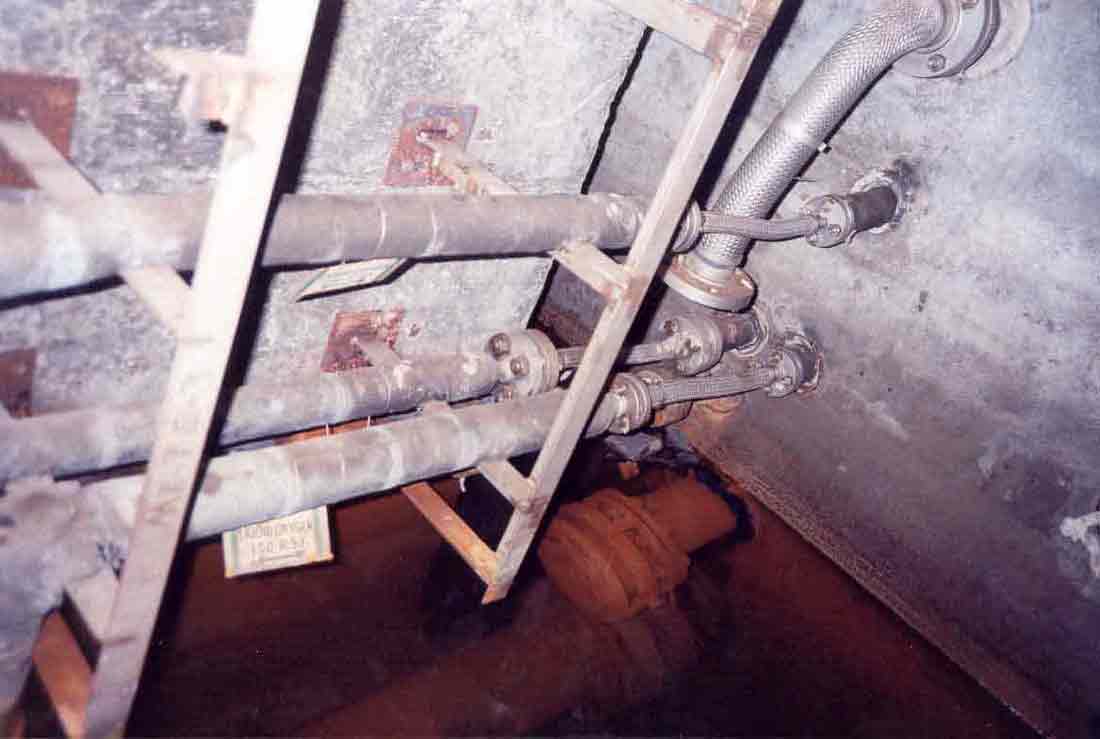
Another
view at launcher #3 where flooding was far greater.
|
|

Piping
and supports on the silo side of the blast wall at silo #3.
|
|

Construction
photo of the silo side of the LOX tunnel
Photo
courtesy of Fred Epler
|
|
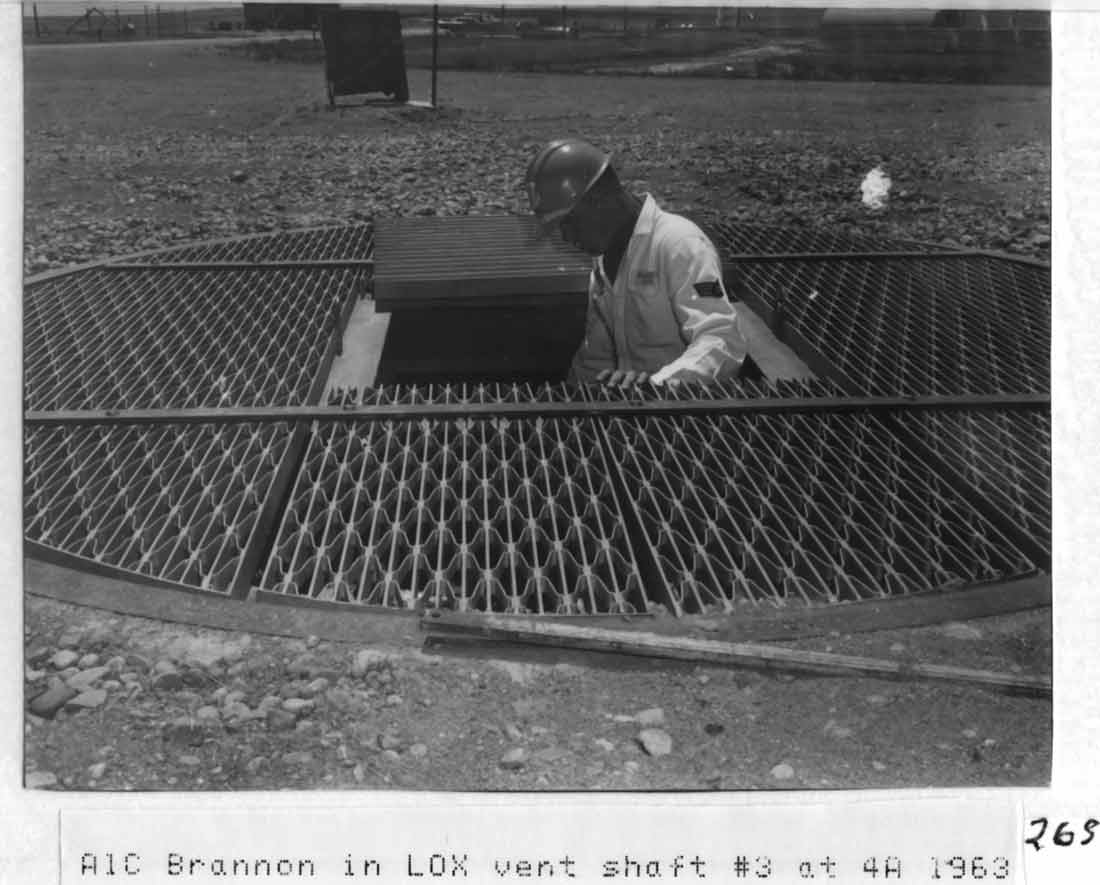
Photo
courtesy of Fred Epler
|
The
LOX loading and vent shaft was one of the few places I never ventured
because there was no easy way to get back there without dismantling a
blast valve. As a result, I never got any photos there, but I did
find a few operational-era photos taken at the surface featuring the
enigmatic A1C Brannon going over maintenance procedures at the valves
and fill connections.
|

Platform
4' below grade where fill valves and piping are located
Photo
courtesy of Fred Epler
|
At
724-C as with some other sites, the LOX loading and vent shaft appears
to have been filled in with dirt and covered over. I decided to
find out if this was the case and with the aid of a shovel found that
the vent shafts (at least at 724-C) are in fact not filled in but simply
covered over with corrugated tin and a layer of soil about 6-8 inches
deep. Still, I did not try to go down there. Too much
trouble even for a determined explorer like me.
|
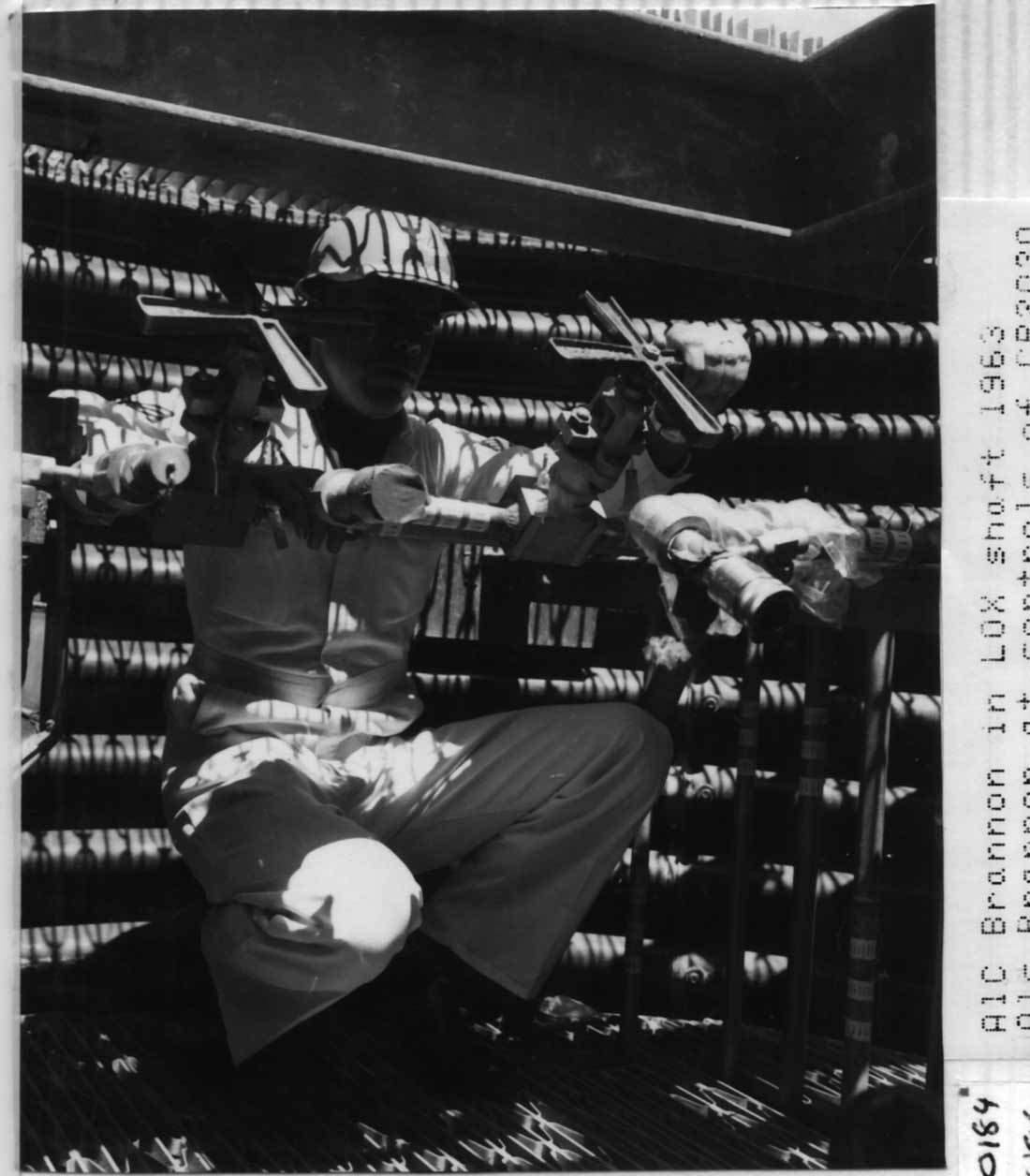
Another
view of the LOX loading and vent shaft with A1C Brannon
Photo
courtesy of Fred Epler
|
This
concludes the LOX tunnels and loading vents section. Select
another location to explore below or go to the main
map for other locations.
Current
Location: LOX Tunnels and Loading Vents
|
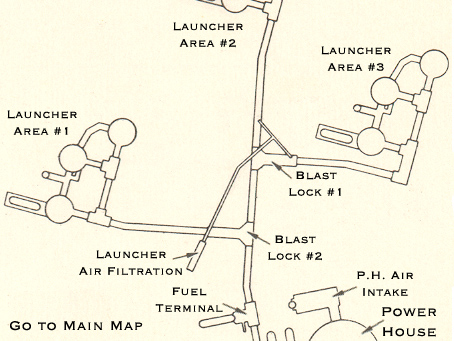
Where
would you like to go next?
|

|
Contact
| Site Map | Links |
Hosted by
InfoBunker

|










































